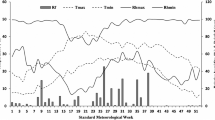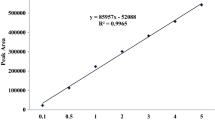Abstract
Metribuzin is a systemic herbicide having translaminar flow in the plant. Therefore, there are chances of movement in the leaves, immature cane and juice. Work has been done on the residues of metribuzin in soil but no literature is available on the residues in immature cane. Therefore, present work is undertaken to check the dissipation pattern in immature cane, juice and soil. A two-year trial was conducted to study the residues of metribuzin after application @ 1400 and 2800 g a.i. ha−1. In immature cane, the initial residues were 11.73 and 20.89 mg kg−1 during 1st year and 12.78 and 26.09 mg kg−1 during 2nd year which declined below the limit of quantification of 0.05 mg kg−1 in 15 days at single and double dose, respectively. In soil, initial residues were 0.87 and 2.56 mg kg−1 during 1st year and 0.94 and 2.83 mg kg−1 during 2nd year at single and double dose, respectively, which decreased below the limit of quantification after 10 and 15 days of application during both years @ 1400 and 2800 g a.i. ha−1, respectively. The total residues followed kinetics of first order with correlation coefficient (R2) of 0.98 and 0.99. Sugarcane juice did not show the residues of metribuzin at harvest time. No residues were found in sugarcane, its juice and soil at harvest time; therefore, it can be concluded that the application of metribuzin @ 1400 and 2800 g a.i. ha−1 is safe from consumption point of view and environment point of view.


Similar content being viewed by others
References
Al-Mughrabi, K.I., B.E. Abu-Irmaileh, and I.K. Nazer. 1999. Residues of the herbicides metribuzin and fluazifop-butyl in soil and lentil seeds and straw. Arab Journal of Plant Protection 17 (2): 66–70.
Anonymous. 2020. https://www.cropscience.bayer.in/Products-H/Brands/Crop-Protection/Herbicide-Sencor.aspx?print=true (assessed on 15th June)
Battu, R., R.L. Kalra, and R.S. Dhillon. 2000. Estimation of residues of carbofuran and its metabolites in sugarcane and soil by derivatization with 1-fluoro-2,4-dinitrobenzene and gas chromatography with nitrogen-phosphorus detection. Journal of Association of Official Analytical Chemists 83 (3): 569–578.
Bansal, R., K. Mandal, R. Kumar, and B. Singh. 2019. Dissipation and persistence of clothianidin in soil following its application in sugarcane field. Agricultural Research Journal 56 (3): 453–458.
Gallaher, K., and T.C. Muller. 1996. Effect of crop presence on persistence of atrazine, metribuzin, and clomazone in surface soils. Weed Science 44 (3): 698–703.
Janaki, P., K.M. Sundaram, C. Chinnusamy, and N. Sakthivel. 2015. Determination of residues of metribuzin in soil and sugarcane by QuEChERS. Asian Journal of Chemistry 27 (10): 3692–3696.
Jiyu, H., D. Zhubo, L. Chang, and Z. Zhixin. 2010. Simultaneous analysis of herbicide metribuzin and quizalofop-p-ethyl residues in potato and soil by GC-ECD. Chromatographia 72 (7): 701–706.
Kalpana, K., P.R. Lal, D.L. Kusuma, and G.L. Khanna. 2013. The effects of ingestion of sugarcane juice and commercial sports drinks on cycling performance of athletes in comparison to plain water. Asian Journal of Sports Medicine 4: 181–189.
Kaur, N. 2013. Weed control in autumn sugarcane (Saccharum spp.) based intercropping systems. Ph. D. Dissertation, Punjab Agricultural University, Ludhiana, India pp. 3.
Khoury, R., A. Geahchan, C.M. Coste, J.F. Cooper, and A. Bobe. 2003. Retention and degradation of metribuzin in sandy loam and clay soils of Lebanon. Weed Research 43 (4): 252–259.
Kulshrestha, G., and S.B. Singh. 2001. Residual fate of metribuzin on carrot (Daucus carota) crop. Bulletin of Environmental Contamination and Toxicology 66: 660–663.
Kumari, S., N. Sharma, R. Joshi, A. Gulati, and P.C. Sharma. 2015. Dissipation studies of metribuzin in alfisol soils and its terminal residues in potato tubers. International Journal of Agriculture, Environment and Biotechnology 8 (2): 449–455.
Ladlie, J.S., W.F. Meggitt, and D. Penner. 1976a. Role of pH on metribuzin dissipation in field soils. Weed Science 24: 508–511.
Ladlie, J.S., W.F. Meggitt, and D. Penner. 1976b. Effect of pH on metribuzin activity in the soil. Weed Science 24: 505–507.
Li, X., Z. Ma, and S. Yao. 2015. Bioactivity-guided systematic extraction and purification supported by multitechniques for sugarcane flavonoids and anthocyanins. Food and Bioproducts Processing 94: 547–554.
Luke, M.A., J.E. Froberg, and H.T. Masumoto. 1975. Extraction and cleanup of organochlorine, organophosphate, organonitrogen, and hydrocarbon pesticides in produce for determination by gas-liquid chromatography. Journal of Association of Official Analytical Chemists- J AOAC Int 58: 1020–1026.
Majumdar, K., and N. Singh. 2007. Effect of soil amendments on sorption and mobility of metribuzin in soils. Chemosphere 66: 630–637.
Mandal, K., and B. Singh. 2013. Dissipation of fipronil granule formulation in sugarcane field soil. Ecotoxicology and Environmental Safety 88: 142–147.
Mandal, K., and B. Singh. 2014. Persistence and metabolism of fipronil in sugarcane leaves and juice. Bulletin of Environmental Contamination and Toxicology 92 (2): 220–224.
Mandal, K., S. Pandher, U. Bhardwaj, P.K. Arora, R.S. Battu, and B. Singh. 2012. Persistence of carbaryl and its risk assessment through consumption of treated grapes. Toxicological and Environmental Chemistry 94 (7): 1443–1452.
Mehdizadeh, M., E. Izadi-Darbandi, M.T. Naseri Pour Yazdi, M. Rastgoo, B. Malaekeh-Nikouei, and H. Nassirli. 2019. Impacts of different organic amendments on soil degradation and phytotoxicity of metribuzin. International Journal of Recycling of Organic Waste in Agriculture. https://doi.org/10.1007/s40093-019-0280-8.
SANTE. 2015. Guidance document on analytical quality control and validation procedures for pesticide residues analysis in food and feed. European commission health and consumer protection directorate-general. SANTE/11945/ 2015 Supersedes SANCO/12571/2013.
Santharam, G., K. Kumar, S. Kuttalam, and S. Chandrasekaran. 2002. Bioefficacy of imidacloprid against termites in sugarcane. Sugar Tech 4: 161–163.
Sharma, S., and B. Singh. 2013. Persistence of imidacloprid and its major metabolites in sugarcane leaves and juice following its soil application. International Journal of Environmental and Analytical Chemistry 94 (4): 319–331.
Solomon, S. 2011. Sugarcane by-products based industries in India. Sugar Tech 13 (4): 408–416.
Solomon, S. 2016. Sugarcane production and development of sugar industry in India. Sugar Tech 18: 588–602.
Sondhia, S. 2005. Phytotoxicity and persistence of metribuzin residues in black soil. Toxicology and Environmental Chemistry 87: 389–397.
Walker, A., S.L. Welch, A. Melacini, and Y.H. Moon. 1996. Evaluation of three pesticides leaching models with experimental data for alachlor, atrazine and metribuzin. Weed Research 36: 37–47.
Zimdahl, R.L., B.K. Cranmer, and W.W. Stroup. 1994. Use of empirical equations to describe dissipation of metribuzin and pendimethalin. Weed Science 42: 241–248.
Acknowledgements
The authors are thankful to the Head of the Department of Entomology, PAU, Ludhiana for providing the necessary research facilities and to "ICAR- All India Network Project on Pesticide Residues" for providing the financial support and facilities for conducting the study.
Author information
Authors and Affiliations
Contributions
SS and KM designed the experiments. SS, NS and KM processing of samples and preparation of manuscript. RK conducted field trial.
Corresponding author
Ethics declarations
Conflict of interest
The authors declare that they have no conflict of interest.
Additional information
Publisher's Note
Springer Nature remains neutral with regard to jurisdictional claims in published maps and institutional affiliations.
Electronic supplementary material
Below is the link to the electronic supplementary material.
Rights and permissions
About this article
Cite this article
Sahoo, S.K., Sharma, N., Mandal, K. et al. Dissipation Kinetics of Metribuzin in Sugarcane and Soil Under Sub-tropical Conditions of Punjab in India. Sugar Tech 23, 1359–1365 (2021). https://doi.org/10.1007/s12355-020-00937-5
Received:
Accepted:
Published:
Issue Date:
DOI: https://doi.org/10.1007/s12355-020-00937-5




